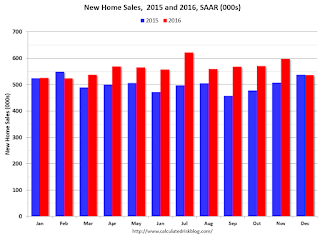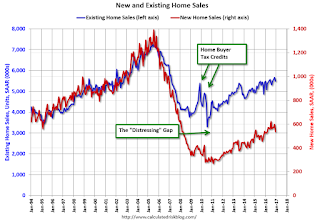New home sales for December were reported at 536,000 on a seasonally adjusted annual rate basis (SAAR). This was well below the consensus forecast, however the previous months combined were revised up slightly.
Sales were down 0.4% year-over-year in December. And sales are up 12.2% in 2016 compared to 2015. This was very solid annual sales growth.
Note that these sales (for December) mostly happened after mortgage rates increased following the election. As I’ve noted before, interest rate changes impact new home sales before existing home sales because new home sales are counted when the contract is signed, and existing home sales at the close of escrow.
This is just one month of data, and overall sales growth was solid in 2016, but we might see a dip in sales due to higher interest rates. If so, this will start impacting expecting existing home sales in January.
On Tuesday, after existing home sales for December were released, I wrote:
With the recent increase in rates, I’d expect some decline in sales volume as happened following the “taper tantrum” in 2013. So we might see sales fall to 5 million SAAR or below over the next 6 months. That would still be solid existing home sales. We might also see a little more inventory in the coming months, and therefore less price appreciation.
It will take several months of data to see the impact of higher mortgage rates – and this is the seasonally weak period – so we might have to wait for the March and April data.
Earlier: New Home Sales decrease to 536,000 Annual Rate in December.

This graph shows new home sales for 2015 and 2016 by month (Seasonally Adjusted Annual Rate). Sales were up 12.2% year-over-year.
Note that December 2015 was a strong month for 2015.
And here is another update to the “distressing gap” graph that I first started posting a number of years ago to show the emerging gap caused by distressed sales. Now I’m looking for the gap to close over the next several years.

Following the housing bubble and bust, the “distressing gap” appeared mostly because of distressed sales. The gap has persisted even though distressed sales are down significantly, since new home builders focused on more expensive homes.
I expect existing home sales to move more sideways, and I expect this gap to slowly close, mostly from an increase in new home sales.
However, this assumes that the builders will offer some smaller, less expensive homes. If not, then the gap will persist.
Note: Existing home sales are counted when transactions are closed, and new home sales are counted when contracts are signed. So the timing of sales is different.
a-few-comments-on-december-new-home-sales

No comments:
Post a Comment